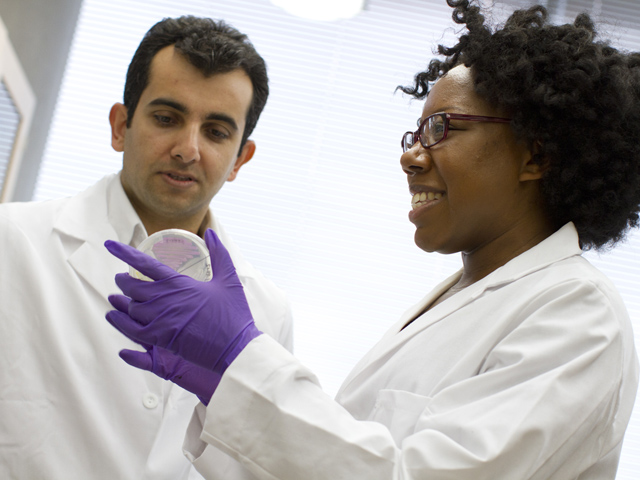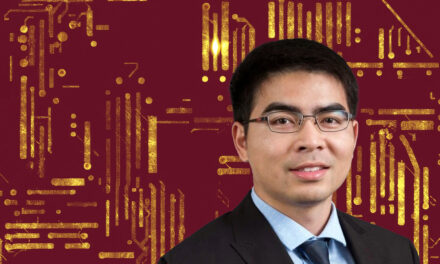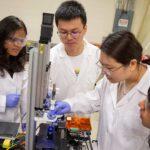
Making strides in synthetic biology research

Bioengineering doctoral student Behzad Damadzedah (left) works in the lab with assistant professor Karmella Haynes. They and others at ASU are seeking ways that synthetic biology research can contribute to new or better treatments for various diseases. Damazedah recently reported on his research at the annual Synthetic Biology Engineering Research Center retreat. Photo: Jessica Slater/ASU.
Posted April 15, 2013
Arizona State University is beginning to establish its place on the map in the burgeoning field of synthetic biology.
Notable strides in research are being made by faculty members and students in the School of Biological and Health Systems Engineering, one of ASU’s Ira A. Fulton Schools of Engineering.
Assistant professor Karmella Haynes was recently the featured speaker on the subject of advances in synthetic biology for the Arizona Science Center’s New Frontiers in Medical Science lecture series.
Some of the data Haynes presented in her talk was derived from research being conducted by bioengineering senior Caroline Hom.
The research involving identification and production of reagents that activate genes in different types of cancer cells earned Hom an opportunity to give a talk about her work at the recent annual conference of the Institute of Biological Engineering (IBE) – a rare achievement for an undergraduate.
At the same conference, students on ASU’s 2012 team for the international Genetically Engineered Machines competition (iGEM) were part of a special panel featuring other students who participated in iGEM, the premiere student synthetic biology competition.
More recently, Haynes took bioengineering doctoral students Behzad Damadzedah and Rene Davis to the University of California, Berkeley, for a semiannual retreat of the Synthetic Biology Engineering Research Center (SynBERC), which is supported by the National Science Foundation.
Damadzedah and Davis exhibited posters at the event that provided details of their ongoing research projects.
Advancing medical research
Synthetic biology involves use of biological components of nature and reconfigures them to perform specific functions. In her Arizona Science Center presentation, Haynes focused on the application of synthetic biology to medical research.
“Because synthetic biology aims to build useful things out of DNA and proteins, I set up my talk by posing the question, ‘Do some things need to be changed in the way that we go about looking for new drugs?’”
The current way is a trial-and-error system that starts with testing diseased cell samples with an array of chemical compounds. If one compound has a successful effect, it is then tested on mice and continues on for clinical trials.
“The problem with that approach is that it’s not rational design, you are not building something with any cellular design principles in mind,” Haynes explains.
In synthetic biology research, biologists and biomedical engineers select specific characteristics from known biological components, and use them to build a synthetic protein that performs a desired function. They can create newer and more effective “smart medicine” that can specifically target one cell type.
Medicine developed from synthetic biology could be more affordable because the method for identifying and producing reagents would eliminate the expensive and lengthy process of testing random chemical compounds. Production costs of the drugs would also be reduced because the drugs would be produced in batches of living cells that multiply on their own.
Suppressing cancer cells
At the Institute of Biological Engineering conference, Hom’s presentation focused on the discovery she made with Haynes that synthetic proteins could be used to turn on tumor suppressors in different cancer types.
The idea for the project sprung from Haynes’ postdoctoral research at Harvard Medical School. Her studies were in osteosarcoma, a common form of bone cancer. She has since wanted to apply her method of building custom proteins to target different types of cancer cells.
When Hom joined Haynes’ lab team as a volunteer in 2011, she got the opportunity to perform basic work profiling different cancer cell types. “Because of the way I’ve designed my protein, you can look for certain signatures and make a prediction about how the cells are going to respond,” Haynes explains.
Hom was encouraged to apply for a fellowship from the Fulton Undergraduate Research Initiative (called FURI, it gives ASU engineering undergraduates some compensation to do advanced research under supervision of a faculty member). The grant allowed Hom to conduct experiments based on Haynes’ and her own earlier discoveries.
“I wanted her to test her predictions by putting the protein into cancer cells and seeing if they turn genes on,” Haynes says.
Hom conducted research ranging from computer-aided analysis of cancer signatures to extracting RNA and performing real-time quantitative polymerase chain reaction (qPCR) experiments to find out what tumor-suppressing genes were activated by the synthetic protein. Cancerous cells often have dormant tumor-suppressors. Reactivating the suppressors with the synthetic protein should halt the growth of cancer cells.
Enhancing career pursuits
ASU’s 2012 iGem team won a gold medal and a Human Practices award at an iGEM regional competition. The team moved on as finalists in the iGEM world championship event at the Massachusetts Institute of Technology. Its project was a portable, low-cost biosensor system to detect pathogens in water supplies, specifically microbes that cause diarrhea.
Since the competition, the group has expanded its work into several spinoff projects. Some students competed in the ASU Innovation Challenge, others received fellowships and FURI grants to continue working in specific areas related to the team’s overall project.
Participating in the iGEM competitions has given the students an advantage in pursuing their careers, Haynes says. “You get a lot more out of it than just the competition prizes. It’s a gateway into professional-level science,” she says.
Helping to fight tuberculosis
At the Synthetic Biology Research Center retreat, Damadzedah presented his research related to the study of the behavior of synthetic proteins in bone cancer cells, an extension of Haynes’ postdoctoral work at Harvard.
Davis presented her research focusing on engineering new ways to get bacteria to communicate.
Using a process known as quorum sensing, Davis is designing microbes that react with a specific behavior in response to a stimulus – in this case yeast cells that turn red. The reaction is intended to respond to the scent molecules produced by patients infected with tuberculosis.
Inspired by Kenyan researchers who trained rats to recognize the unique scent of the breath of tuberculosis patients, researchers identified the molecular compounds of this scent, which helped synthetic biologists develop simple and inexpensive diagnostic systems.
Current methods require patients to cough up phlegm samples for specialists to examine and test. It is this costly and time-consuming procedure that Davis is working to replace. But recognizing the need to focus on one attainable portion of the biosensor system, she chose to research an effective signal amplification mechanism to engineer into yeast.
“We want to build a chain reaction where an activated cell produces a signal compound that goes to other cells and turns them on, causing them to express the same signal,” Haynes explains. “This system could be applied beyond tuberculosis diagnosis, and be used to signal the presence of other stimulus compounds.”
The work helped Davis win an Achievement Reward for College Scientists Fellowship from the ARCS Foundation that provided $7,000 to support her research, which she can also use to travel to more conferences to present her discoveries.
Written by Natalie Pierce and Joe Kullman



































